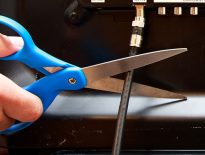I’m a techie, and I like equipping my home with a lot of tech equipment, especially when it comes to media and audio/video (A/V) equipment. However, this penchant for adding new tech has the potential to really complicate things. When you have a streaming device, a TV, an A/V receiver, a video game console, and a cable box all hooked up together it becomes complicated to just watch ESPN. What set of remotes do I use? Which input does the TV have to be on? The A/V receiver? Which remote do I use to change channels? To control the volume?
Editor’s Note: I’ve decided I don’t need the perfect remote anymore. Here’s why.
If I put my family through having to remember all this and more to watch TV, play video games, etc. I’m pretty sure I’d have a revolt. Guests would never be able to watch anything. Enter the Universal Remote.

Table of Contents
Features of the Perfect Universal Remote
I have specific ideas of what would be my perfect remote. Ideally the perfect universal remote makes it simple for anyone to watch anything, without training. It should be the only remote in the room. Commands from the remote control should be close to instantaneous, and line of sight to the equipment should not be needed. How does a remote accomplish this? With the following features:
Every button is customizable.
The design of remotes is never perfect for every situation. The way to handle this is to allow the programmer ultimate control of which buttons do what and under what circumstances.
Speaking of buttons, some (most?) of them should be physical and backlit. Buttons should have a tactile feel for common activities so that you can use them without having to look down at the remote. And should you have to look down it would be great if you can see the buttons in the dark.
It should be web programmable, mobile app programmable, and programmable without Internet access.
Being able to do programming from a web browser can be more efficient than programming from an app when starting from scratch. Programming with an app is great because you can make adjustments on the fly, in the room the remote will control, without having to have a laptop or go back and forth from a desktop. Having the ability to program a remote with local software without an Internet connection at least gives you the ability to update your remote if your Internet connection is down, or the remote provider’s network is down or they go out of business. It would be great if a backup of the configuration could be saved locally as well. In any case, no wires should be needed. Remotes should be able to be programmed via Wifi and/or Bluetooth. It might even be cool if a remote ran it’s on web service like a router that you could modify. A Mensa membership should not be a prerequisite for using the programming software.
It should support network (IP), Bluetooth, RF, and IR control
IR needs line of sight and is easily defeated. IP, Bluetooth, and RF do not need line of sight. In general, IP is best because it is reliable and can provide two-way communication with the remote for more complicated and precise control, as can Bluetooth. You still need RF and IR in case you have equipment that doesn’t support other methods. Some devices (game consoles, FireTV devices) support Bluetooth control. More and more are supporting network control. It would also be nice if the remote offered a local API for integration with systems like Home Assistant.
Examples of Close to Perfect Universal Remotes
I’ve used and researched a lot of universal remotes over the years. Here are my thoughts on some popular remotes out there:
Harmony Elite/Ultimate/Companion/Smart Control
These Harmony Hub based remotes all offer similar functionality (read my review here). The Harmony Elite and the Harmony Ultimate offer customizable touch screens. The Companion and Smart Control don’t have touch screens and cost less, but with the hub have most of the same functionality.
Close to perfect because…
- Supports IP, Bluetooth, and IR control
- Has physical buttons, all of which can be configured
- They are web and app programmable
Not quite perfect because…
- No supported way to modify remote without Internet Access
- There is a desktop programming app, but no web programming interface
- Doesn’t control all devices that are capable of IP control via IP
- Programming app is not the most intuitive for customizing the remote
- No RF control
Caavo Universal Remote
Caavo Control Center takes an alternate approach to remote control by adding in machine learning and using HDMI CEC.
Close to perfect because…
- IP, HDMI CEC, Bluetooth, and IR control. Even controls some apps.
- Programming is close to automatic as it can discover many of your devices on its own, and you can use an app
- Has physical buttons
- Has voice navigation
Not quite perfect because…
- Requires a monthly subscription fee for many features
- Remote is arguably too minimalist. No configurable touchscreen
Neeo Smart Remote
The Neeo Smart Remote is a newcomer to the scene that tries to combine elegance with beauty, smarts, and functionality.
Close to perfect because…
- IP, Bluetooth, and IR control. Even controls some apps.
- Works with smarthome devices too (Zigbee and Z-Wave).
- Beautiful and customizable touchscreen on the remote
- Has physical buttons
Not quite perfect because…
- No web or offline programming
- Remote is arguably too minimalist. Not enough physical buttons
- It is new and crowdfunded so not sure how long it will be around: EDIT – 2/5/2019: It has been bought by Control4 and is no longer available for sale to consumers (thanks Phil Hawthorne!)
Final Thoughts
These are not the only remotes out there. The URC Total Control remotes look wonderful, control via multiple protocols, have physical buttons and a touchscreen, but require a professional installer to program and customize, and are expensive. The FireTV Cube combines voice control, Alexa and FireTV for a different take on the remote control. There are also IP2IR and network-based solutions as well, but none of them are perfect. The Harmony Hub solutions seem the closest to me as they combine almost all the protocols, multiple methods of programming, and give you lots of options for which physical remote to use.
In the absence of the perfect remote, I’ve settled on the simplest inexpensive remote. Here’s my review of the SofaBaton R2 Universal Roku replacement remote.
I hope all these solutions improve and eventually evolve into the perfect remote!
This page contains affiliate links. If you purchase an item using an affiliate link I will receive a small commission at no cost to you. Affiliates do not influence my recommendations. Read my disclosures for more information.




